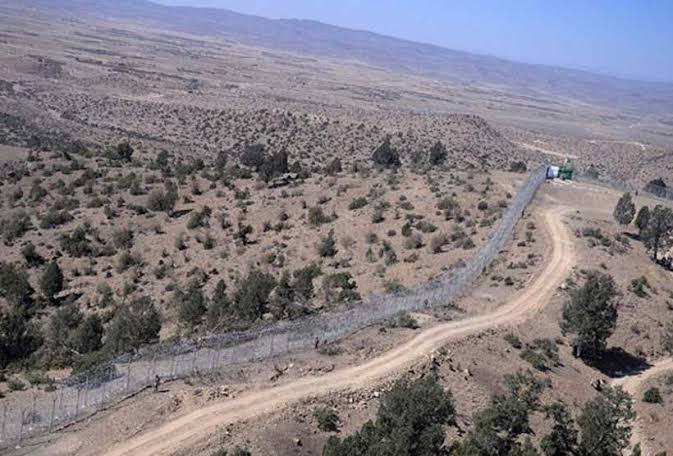Durand Line turning into conflict line

The Durand Line passes through the present-day Pakistani provinces of Khyber Pakhtunkhwa (NWFP), Federally Administered Tribal Areas (FATA) and Baluchistan. It was drawn after the first Afghan British War but never accepted by Afghan Governments or by Afghan people ever since.
There has been border conflict between Pakistan and Afghanistan over Durand Line since 1947. The line divides not just the two countries but also the Pashtuns and remains a bone of contention between the two nations. It also includes 10 provinces in Afghanistan. Disputed in the context of the struggle for the Pashtun homeland, it has of late become the cause of heightened border tensions between Pakistan and Afghanistan, according to reports.
The refusal of Taliban to accept the status of the border between Pakistan and Afghanistan has clearly shown the cracks in the relationship between the two countries.
However, Durand Line is not the only bone of contention between the countries as both the nations do not see eye to eye on a range of issues like expelling Baloch insurgents, dismantling, degrading and destroying Tehrik-e-Taliban Pakistan (TTP) and allowing education for girls and giving women rights,
According to Al Arabiya, the growing rancour between the two countries was manifested in a recent incident on September 19, wherein Afghan security guards posted at Pakistan Consulate, Jalalabad mistreated Pakistan diplomats.
They also stopped the President and two members of the Nangarhar Chamber of Commerce from meeting the Pak Consulate General.
While Pakistan accuses Afghanistan of harbouring anti-Pakistan elements, Tehreek-e-Taliban Pakistan (TTP) on its soil, the Taliban do not recognize the Durand Line which separates the two countries and divides the home of ethnic Pashtuns.
Since the Taliban seized power in Afghanistan in August 2021, Pakistan has been trying to persuade the Afghan Taliban to crack down on TTP. Instead, the Afghan Taliban mediated talks between Pakistan and TTP that led to the release of dozens of TTP prisoners in Pakistan, reported Al Arabiya.
Islamabad was partly optimistic in the wake of the Taliban takeover. It hoped that the Taliban regime would accept the Durand Line’s legitimacy and leverage its links with the proscribed organization Tehreek-e-Taliban Pakistan (TTP) to broker a peace agreement.
While Taliban links have facilitated Islamabad-TTP talks, which led to a ceasefire, the Taliban seems reluctant to apply total pressure on the TTP. The Taliban is also in no mood to grant any concessions on the issue, given that skirmishes between themselves and Pakistani troops continue.
In the wake of this, there have been repeated reports of firing and clashes between the security forces of the two countries at the border.
Recently footage of the Taliban forces driving into Pakistan’s side of the Durand line surfaced on social media.
While Afghan media reported that Taliban members went to talk to the Pakistani side but the other side opened fire which caused casualties, the media affairs wing of the Pakistan military said that three Pakistani soldiers were killed in firing by “terrorists from inside Afghanistan” in the general area of Kharlachi in the Dand Patan area of the province.
In a similar clash in August this year, Taliban-led forces and Pakistani soldiers exchanged gunfire in the Dangam district and Pakistani forces fired mortar shells.
A major inflection point in Pak-Afghan relations came in April 2022, when on April 16, 2022, the Pakistani military conducted predawn airstrikes on multiple targets in Afghanistan’s Khost and Kunar provinces. Afghan officials alleged that the attacks killed at least 47 civilians and injured 23 others, mostly women and children, reported Al Arabiya.
Initial reports described the attacks as either rocket strikes or aerial strikes carried out by Pak air force. However, initially, Islamabad denied any involvement in the airstrikes, but Pakistani security officials later claimed that these were drone strikes from inside Pakistani airspace and that no aircraft were deployed.
The airstrikes were apparently in retaliation to the increased attacks by TTP on Pak security forces from sanctuaries inside Afghanistan. On April 14, 2022, the Pakistani military acknowledged that nearly 100 soldiers had been killed by militants since January 2022, reported Al Arabiya.
According to various Pakistan data sources, the TTP, since its inception in 2007, had carried out over 3000 terrorist attacks in Pakistan, killing about 7500 persons, including over 2500 security personnel, of which 815 were from the army.
The most horrendous was the attack on an Army school in Peshawar in which TTP militants killed over 132 students and 17 others in December 2014. The most strong opponents to the present round of talks with the TTP were the family members of the slain children.
Terrorism had spread across Khyber Pakhtunkhwa province as several targeted attacks on local leaders and police in the province were reported in the past months.
According to local residents, as many as 186 incidents were reported in North Waziristan from 2019 till June 2022. If compared with any other merged district, the number of such incidents was 56 in South Waziristan, nine each in Orakzai and Kurram, 16 in Mohmand, 12 in Khyber and 61 in Bajaur since 2019.
Attacks on policemen and other law enforcement agencies have continued in southern districts as well as in Peshawar in the past year. Over 63 policemen have died in targeted killings and other attacks this year. Besides, armed attackers have attacked several police stations, posts and vans with grenades in recent months.



